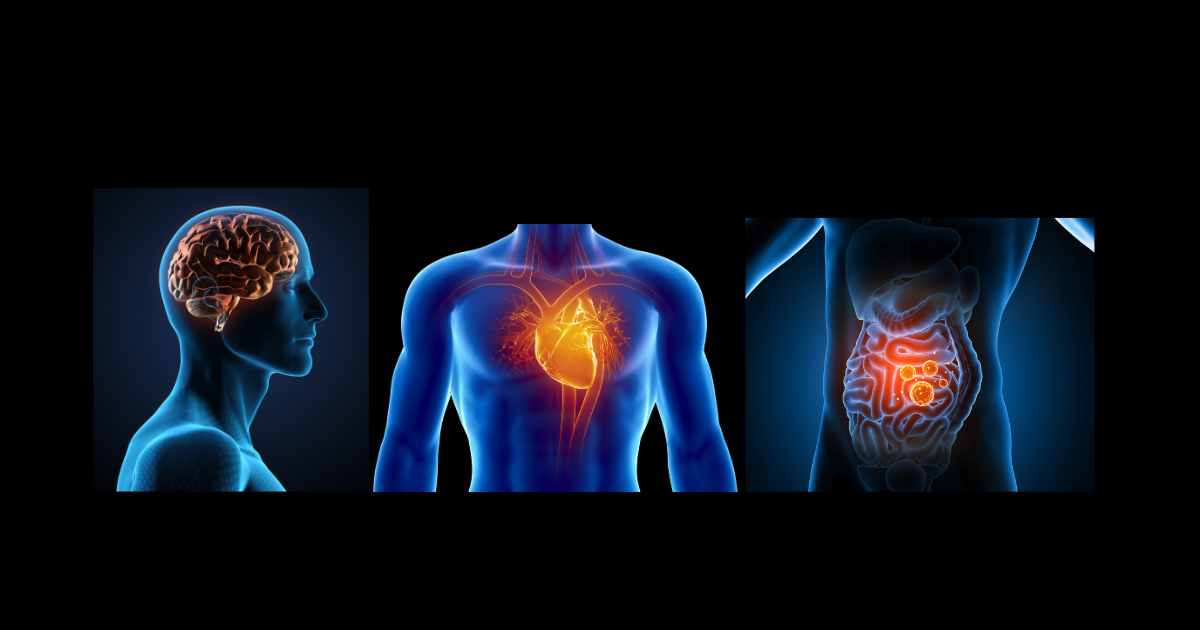The One True Brain (and the Other Two "Brains" People Like to Talk About)
You might have heard people refer to your gut and heart as "brains," but in reality, we only have one true brain—located in our head. The gut and heart contain networks of neurons that can act semi-independently and communicate with the brain, giving rise to the concept of three "brains"—the gut brain, heart brain, and head brain. Together, these systems form a communication network that influences your health, emotions, and overall well-being.
While the gut and heart have critical roles, they depend on the head brain for overall coordination and control. Let’s explore the science behind each of these systems and why the head brain remains the master controller.
The Three "Brains" (But Really, Just One)
1. The Gut Brain (Enteric Nervous System)
The gut brain, or enteric nervous system (ENS), is often referred to as the "second brain" because it has more than 100 million neurons and operates largely independently to regulate digestion. However, the gut does much more than manage food. It produces around 90% of the body’s serotonin, a neurotransmitter that plays a key role in mood regulation, which is why gut health has such a strong connection to emotional health.
Bi-directional Communication: The gut-brain axis describes the two-way communication between the gut and the head brain. For example, the head brain tells the gut to prepare for food when you're hungry, and the gut alerts the brain when something harmful has been consumed, leading to feelings of nausea.
Gut-Brain Communication: This communication happens primarily through the vagus nerve. When the gut is in balance, it can positively affect mood and stress levels, but when gut health is disrupted, it can lead to issues like anxiety and depression.
With the brain and gut so intertwined, it’s no surprise that clinicians treating gastrointestinal disorders often recommend cognitive-based approaches like talk therapy, hypnosis, or relaxation techniques. These strategies can help manage gut health by calming the mind. Conversely, mental health professionals may also need to consider the patient’s gut health when addressing cognitive symptoms, recognizing the deep connection between the two.
2. The Heart Brain (Cardiac Nervous System)
The heart brain refers to the network of approximately 40,000 neurons within the heart, known as the cardiac nervous system. These neurons help regulate heart function, allowing the heart to respond quickly to changes in the body.
While the heart doesn’t "think" in the way the head brain does, it does influence emotional states through heart rhythms. Positive emotions like gratitude and love create heart-brain coherence, where the heart's rhythms are more ordered and harmonious, which in turn improves cognitive function and emotional regulation.
Heart-Brain Connection: The heart communicates with the head brain through the autonomic nervous system, influencing how we feel and think. Maintaining coherent heart rhythms can help regulate stress and promote emotional well-being.
3. The Head Brain (Central Nervous System)
The head brain, or central nervous system (CNS), is the true brain that controls everything from thoughts and emotions to movements and bodily functions. It consists of the brain and spinal cord, and while the gut and heart can function semi-independently, they depend on the head brain for overall coordination.
The head brain integrates signals from the gut and heart, making decisions that regulate everything from digestion to emotional responses.
The Head Brain is Central
While people may refer to the gut and heart as "brains," the head brain is the true master controller. It processes signals from the gut and heart and ensures that all systems work together to keep the body in balance.
If the head brain becomes severely damaged or inactive — a condition known as brain death — the body’s functions cease. Even though the heart may still beat and the gut may still digest food for a while, without the head brain, there’s no consciousness or meaningful life.
How the Gut, Heart, and Head Brain Work Together
Although we have only one true brain, the gut, heart, and head brain are constantly communicating to maintain physical and emotional health.
Gut-Brain Axis: The gut sends signals to the head brain about digestion, but it also impacts mental health by producing neurotransmitters like serotonin. An unhealthy gut can lead to issues like anxiety or depression.
Heart-Brain Coherence: The heart’s rhythms can influence emotions and cognitive clarity. When the heart is in a coherent state, emotional resilience and mental clarity improve.
The head brain integrates these signals, ensuring that the body functions as one coordinated system.
Conclusion: We Only Have One Brain (But It's Great to Talk About All Three)
While some people refer to the gut and heart as "brains," we only have one true brain — the head brain. The gut and heart play crucial roles in digestion, emotions, and health, but they rely on the head brain to bring everything together.
Understanding this interconnected system allows us to better manage our health by maintaining gut health, promoting heart-brain coherence, and optimizing brain function.
Curious to learn more?
This blog explores The Brain-Body Connection and how your brain influences every part of your body.
This blog explores Brain Neuroplasticity where you can learn how your brain evolves, adapts, and grows over time.
Did you know that your Visual, Auditory, and Kinesthetic (VAK) senses play a vital role in how your brain, gut, and heart communicate?
By tapping into these sensory systems, you can reduce stress, enhance emotional regulation, and improve your overall well-being.
To dive deeper into this, download my workbook designed to walk you through the powerful process of connecting with your Visual, Auditory, and Kinesthetic (VAK) senses. This workbook gives you actionable steps to begin understanding how your brain naturally processes the world and how you can use this to manage stress, reduce tension, and create lasting calm.
. . .
If you’d like to learn more about your brain and how it’s been influencing your life and how you can use its power to make the changes you want, reach out at the link below to schedule a strategy call.
References
Armour, J. A. (2008). Potential clinical relevance of the ‘little brain’ on the mammalian heart. Experimental Physiology, 93(2), 165-176. https://doi.org/10.1113/expphysiol.2007.038539
Bonaz, B., Bazin, T., & Pellissier, S. (2018). The vagus nerve at the interface of the microbiota-gut-brain axis. Frontiers in Neuroscience, 12, 49. https://doi.org/10.3389/fnins.2018.00049
Breit, S., Kupferberg, A., Rogler, G., & Hasler, G. (2018). Vagus nerve as modulator of the brain–gut axis in psychiatric and inflammatory disorders. Frontiers in Psychiatry, 9, 44. https://doi.org/10.3389/fpsyt.2018.00044
Carabotti, M., Scirocco, A., Maselli, M. A., & Severi, C. (2015). The gut-brain axis: Interactions between enteric microbiota, central and enteric nervous systems. Annals of Gastroenterology, 28(2), 203-209.
Cryan, J. F., & Dinan, T. G. (2012). Mind-altering microorganisms: The impact of the gut microbiota on brain and behaviour. Nature Reviews Neuroscience, 13(10), 701-712. https://doi.org/10.1038/nrn3346
Ford, A. C., Talley, N. J., Schoenfeld, P. S., Quigley, E. M., & Moayyedi, P. (2009). Efficacy of antidepressants and psychological therapies in irritable bowel syndrome: Systematic review and meta-analysis. Gut, 58(3), 367-378. https://doi.org/10.1136/gut.2008.163162
Keefer, L., Kahrilas, P. J., Shanahan, K., & Valley, V. M. (2019). Behavioral interventions for gastrointestinal disorders: How GI psychology fills the gaps. Current Treatment Options in Gastroenterology, 17(2), 190-198. https://doi.org/10.1007/s11938-019-00220-w
Mayer, E. A., Knight, R., Mazmanian, S. K., Cryan, J. F., & Tillisch, K. (2014). Gut microbes and the brain: Paradigm shift in neuroscience. Journal of Neuroscience, 34(46), 15490-15496. https://doi.org/10.1523/JNEUROSCI.3299-14.2014
McCraty, R., & Childre, D. (2010). Coherence: Bridging personal, social, and global health. Alternative Therapies in Health and Medicine, 16(4), 10-24.
Thayer, J. F., & Lane, R. D. (2009). Claude Bernard and the heart-brain connection: Further elaboration of a model of neurovisceral integration. Neuroscience & Biobehavioral Reviews, 33(2), 81-88. https://doi.org/10.1016/j.neubiorev.2008.08.004
Yano, J. M., Yu, K., Donaldson, G. P., Shastri, G. G., Ann, P., Ma, L., ... & Hsiao, E. Y. (2015). Indigenous bacteria from the gut microbiota regulate host serotonin biosynthesis. Cell, 161(2), 264-276. https://doi.org/10.1016/j.cell.2015.02.047

